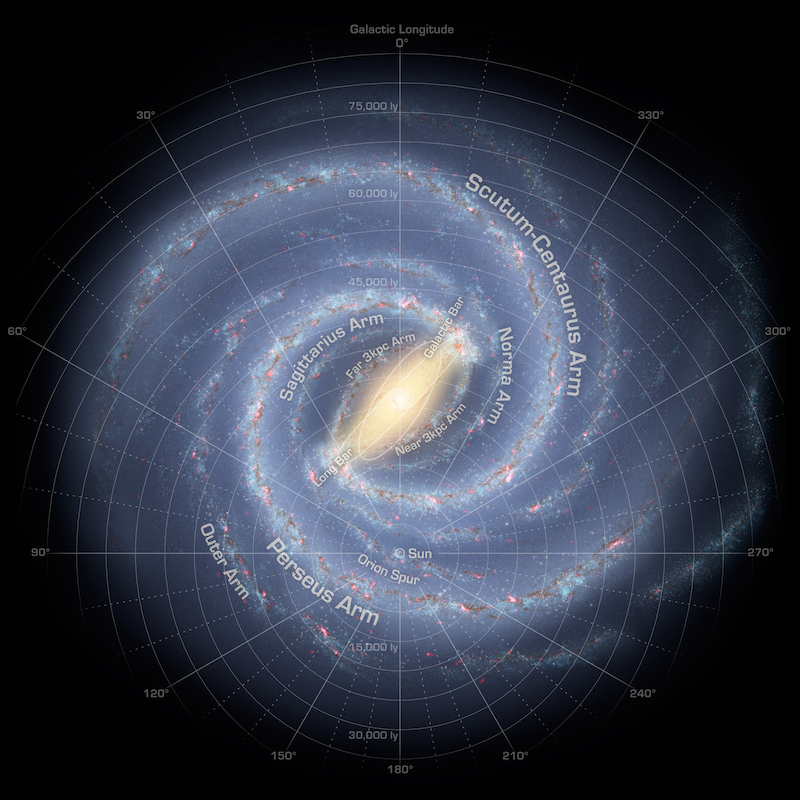
Have you read Isaac Asimov’s classic sci fi series, the Foundation trilogy of 1951 to 1953? Or maybe you’ve watched the resulting Foundation TV series, whose second season is set to premiere in July, 2023? If so, like many before you, you might recognize the center of our home galaxy, the Milky Way, as a potential seat of power of any hypothetical galactic civilization. So it’s not surprising that, in the collective effort known as the Search for Extraterrestrial Intelligence (SETI), scientists would eventually aim our world’s radio telescopes toward our galaxy’s center. A new mission – called Breakthrough Listen Investigation for Periodic Spectral Signals – aka BLIPSS – is starting to do just that.
BLIPSS is a collaboration between Cornell University, the SETI Institute and Breakthrough Listen. The SETI Institute announced the ambitious new endeavor on May 30, 2023.
Akshay Suresh, a graduate student at Cornell University, is heading the new project. The objective is to look for periodic signals coming from the dense core region of the galaxy, with millions of stars.
The astronomers published a preview of their new peer-reviewed paper on May 30. It has been accepted for publication in The Astronomical Journal.
SETI looks to heart of Milky Way
BLIPSS is focusing on listening to stars in the core of the Milky Way rather than the vast spiral arms, which our own sun is in. It seems like a logical place to search, since this heart of our galaxy is packed with millions of stars. In fact, If you lived in the center of the Milky Way, you would see a night sky with up to one million more stars than we do.
We already know that most stars across the galaxy have planets – including potentially habitable ones – so it’s likely that these stars do also. This dense region of the galaxy would be a great place to send out a beacon or other kind of radio communication. The odds of being able to detect such a signal would go up significantly. This is simply because there are so many stars packed into the central part of the Milky Way.
Indeed, as Suresh noted:
BLIPSS showcases the cutting-edge potential of software as a science multiplier for SETI.
He added:
Our study introduces to SETI, for the first time, the Fast Folding Algorithm (FFA); our open-source software utilizes an FFA to crunch over 1.5 million time series for periodic signals in roughly 30 minutes.
Pulsed signals
So far, SETI has primarily looked for continuous radio signals, such as the faint leakage of ongoing radio waves into space. This would be similar to how our own earthly civilization sends out continuous signals from transmitters, satellites, etc. But BLIPSS wants to search for pulsed signals instead. These signals would be more periodic, or pulsed, designed to send a specific message to other civilizations in the galaxy, like a beacon. SETI Institute astronomer Vishal Gajjar, one of Suresh’s advisors on the project, said:
Until now, radio SETI has primarily dedicated its efforts to the search for continuous signals. Our study sheds light on the remarkable energy efficiency of a train of pulses as a means of interstellar communication across vast distances. Notably, this study marks the first-ever comprehensive endeavor to conduct in-depth searches for these signals.

Testing the algorithm
What would be a good way to test the algorithm of BLIPSS? Try it out on pulsars, of course. Although natural phenomena, pulsars emit regular radio signals as well. And it worked. The researchers successfully detected the periodic emissions.
But what about repeating radio signals that are not natural in origin? For this initial effort, the researchers used a dataset of scans of the Galactic Center. The Breakthrough Listen instrument on the Green Bank Telescope (GBT) in West Virginia captured this dataset of radio emissions.
Pulsars, although repeating, can emit signals across a wide range of frequencies. The researchers wanted to focus on looking for signals that were much narrower, like terrestrial artificial radio signals. With this in mind, BLIPSS narrowed its search to repeating signals within a frequency range covering less than a tenth of the width of an average FM radio station.
The advantage of the new method is that it searches for signals that are both narrow and periodic, not just one or the other. Co-author Steve Croft at Breakthrough Listen said:
The combination of these relatively narrow bandwidths with periodic patterns could be indicative of deliberate technological activities of intelligent civilizations. Breakthrough Listen captures huge volumes of data, and Akshay’s technique provides a new method to help us search that haystack for needles that could provide tantalizing evidence of advanced extraterrestrial life forms.
The BLIPSS software is also publicly available to download.
Bottom line: A new SETI collaboration is searching for repeating artificial radio signals from alien civilizations in the heart of our Milky Way galaxy.
Source: A 4–8 GHz Galactic Center Search for Periodic Technosignatures











